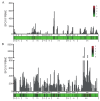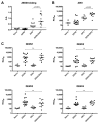Improved Immune Responses Against Zika Virus After Sequential Dengue and Zika Virus Infection in Humans
- PMID: 30205518
- PMCID: PMC6164826
- DOI: 10.3390/v10090480
Improved Immune Responses Against Zika Virus After Sequential Dengue and Zika Virus Infection in Humans
Abstract
The high levels of dengue-virus (DENV) seroprevalence in areas where the Zika virus (ZIKV) is circulating and the cross-reactivity between these two viruses have raised concerns on the risk of increased ZIKV disease severity for patients with a history of previous DENV infections. To determine the role of DENV preimmunity in ZIKV infection, we analyzed the T- and B-cell responses against ZIKV in donors with or without previous DENV infection. Using peripheral blood mononuclear cells (PBMCs) from donors living in an endemic area in Colombia, we have identified, by interferon (IFN)-γ enzyme-linked immunospot (ELISPOT) assay, most of the immunodominant ZIKV T-cell epitopes in the nonstructural (NS) proteins NS1, NS3, and NS5. Analyses of the T- and B-cell responses in the same donors revealed a stronger T-cell response against peptides conserved between DENV and ZIKV, with a higher level of ZIKV-neutralizing antibodies in DENV-immune donors in comparison with DENV-naïve donors. Strikingly, the potential for antibody-mediated enhancement of ZIKV infection was reduced in donors with sequential DENV and ZIKV infection in comparison with donors with DENV infection only. Altogether, these data suggest that individuals with DENV immunity present improved immune responses against ZIKV.
Keywords: T-cell epitopes; antibody-dependent-enhancement (ADE); cross-reactive T cells; dengue virus; immunodominance; neutralizing antibodies; zika virus.
Conflict of interest statement
The authors declare that they have no conflict of interest.
Figures





Similar articles
-
Immune Responses to Dengue and Zika Viruses-Guidance for T Cell Vaccine Development.Int J Environ Res Public Health. 2018 Feb 23;15(2):385. doi: 10.3390/ijerph15020385. Int J Environ Res Public Health. 2018. PMID: 29473899 Free PMC article. Review.
-
Modulation of Dengue/Zika Virus Pathogenicity by Antibody-Dependent Enhancement and Strategies to Protect Against Enhancement in Zika Virus Infection.Front Immunol. 2018 Apr 23;9:597. doi: 10.3389/fimmu.2018.00597. eCollection 2018. Front Immunol. 2018. PMID: 29740424 Free PMC article. Review.
-
Sustained Specific and Cross-Reactive T Cell Responses to Zika and Dengue Virus NS3 in West Africa.J Virol. 2018 Mar 14;92(7):e01992-17. doi: 10.1128/JVI.01992-17. Print 2018 Apr 1. J Virol. 2018. PMID: 29321308 Free PMC article.
-
T Cell Responses to Nonstructural Protein 3 Distinguish Infections by Dengue and Zika Viruses.mBio. 2018 Aug 7;9(4):e00755-18. doi: 10.1128/mBio.00755-18. mBio. 2018. PMID: 30087165 Free PMC article.
-
Prior Dengue Virus Exposure Shapes T Cell Immunity to Zika Virus in Humans.J Virol. 2017 Nov 30;91(24):e01469-17. doi: 10.1128/JVI.01469-17. Print 2017 Dec 15. J Virol. 2017. PMID: 28978707 Free PMC article.
Cited by
-
Arbovirus coinfection and co-transmission: A neglected public health concern?PLoS Biol. 2019 Jan 22;17(1):e3000130. doi: 10.1371/journal.pbio.3000130. eCollection 2019 Jan. PLoS Biol. 2019. PMID: 30668574 Free PMC article.
-
Late Neurological Consequences of Zika Virus Infection: Risk Factors and Pharmaceutical Approaches.Pharmaceuticals (Basel). 2019 Apr 17;12(2):60. doi: 10.3390/ph12020060. Pharmaceuticals (Basel). 2019. PMID: 30999590 Free PMC article. Review.
-
Peculiarities of Zika Immunity and Vaccine Development: Lessons from Dengue and the Contribution from Controlled Human Infection Model.Pathogens. 2022 Feb 25;11(3):294. doi: 10.3390/pathogens11030294. Pathogens. 2022. PMID: 35335618 Free PMC article. Review.
-
Two Is Better Than One: Evidence for T-Cell Cross-Protection Between Dengue and Zika and Implications on Vaccine Design.Front Immunol. 2020 Mar 25;11:517. doi: 10.3389/fimmu.2020.00517. eCollection 2020. Front Immunol. 2020. PMID: 32269575 Free PMC article. Review.
-
Serologic Tools and Strategies to Support Intervention Trials to Combat Zika Virus Infection and Disease.Trop Med Infect Dis. 2019 Apr 19;4(2):68. doi: 10.3390/tropicalmed4020068. Trop Med Infect Dis. 2019. PMID: 31010134 Free PMC article. Review.
References
Publication types
MeSH terms
Substances
Grants and funding
LinkOut - more resources
Full Text Sources
Other Literature Sources
Medical
Research Materials
Miscellaneous

